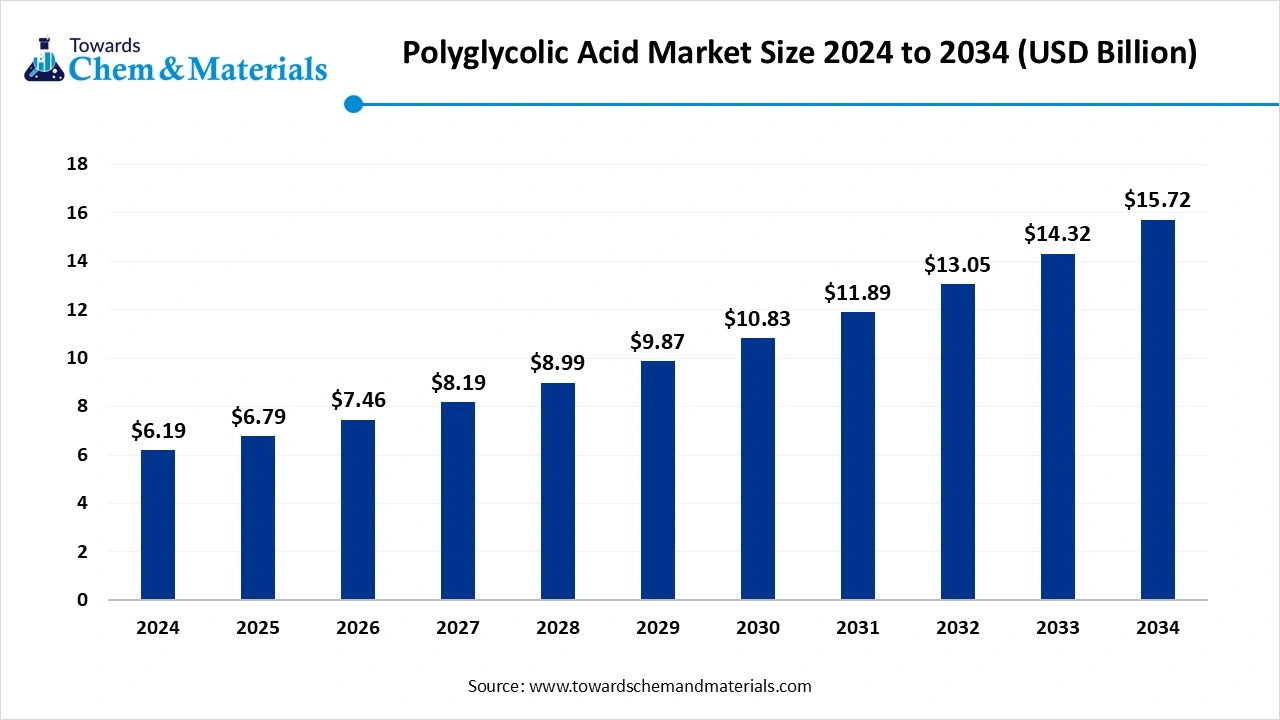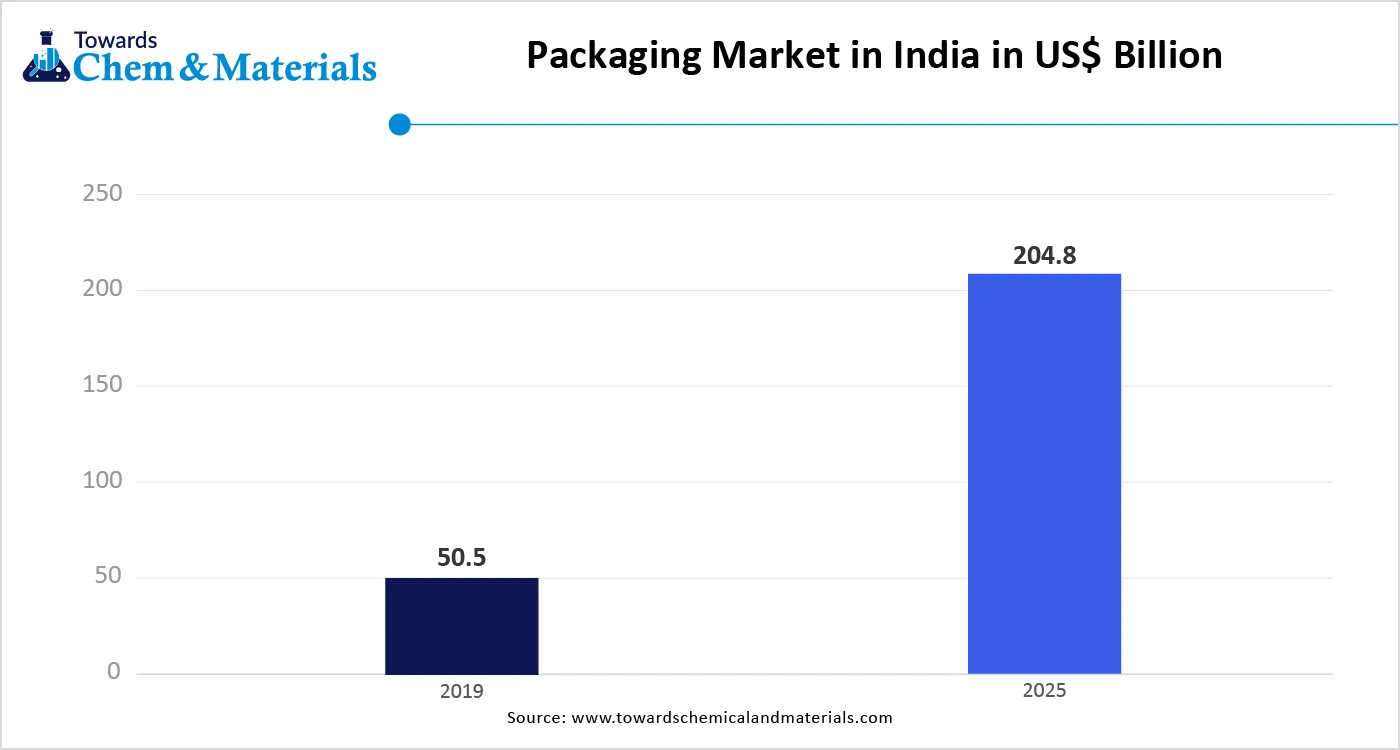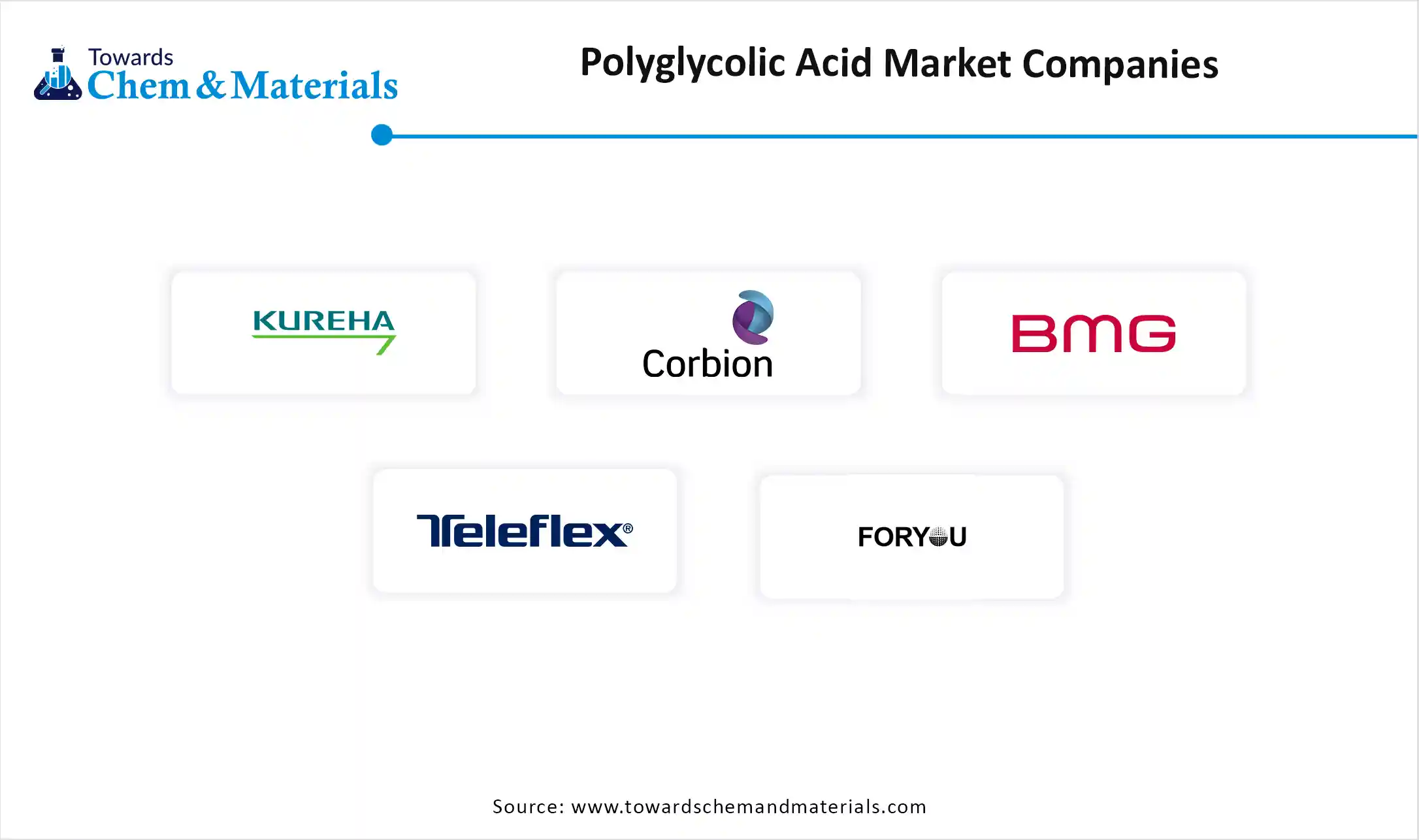December 2025
The global polyglycolic acid market size was estimated at USD 6.19 billion in 2024 and is predicted to increase from USD 6.79 billion in 2025 to approximately USD 15.72 billion by 2034, expanding at a CAGR of 9.77% from 2025 to 2034. The growing expansion of the packaging industry and rising demand across medical applications drive the market growth.

Polyglycolic acid (PGA) is an aliphatic polyester with high crystallinity. It is a thermoplastic, synthetic, and biodegradable polymer. Polyglycolic acid has high tensile strength and is a stiff material. PGA is a relatively brittle, biodegradable, and degrades quickly. It consists of a high melting point and has a glass transition temperature around 35-40 0C. It can be reshaped multiple times and is insoluble in organic solvents. PGA is widely used in surgical sutures due to its flexibility and strength.
The biomedical applications, like orthopaedic devices, drug delivery systems, and dental implants, increase demand for PGA due to its biodegradability & biocompatibility. The increasing medical applications like tissue engineering, surgical sutures, and bioresorbable implants, increase demand for PGA. The growing expansion packaging industry fuels demand for polyglycolic acid. The growing demand across various end-user industries like healthcare, oil & gas, consumer goods, and agriculture contributes to the overall growth of the market.
The growing expansion of the packaging industry leads to higher demand for sustainable packaging solutions. The increasing focus on lowering plastic waste is fueling demand for PGA for packaging. The rising demand for packaged food and consumer goods creates demand for PGA packaging to ensure freshness. The increasing pharmaceutical packaging fuel demand for PGA for biodegradability and to maintain integrity. The growing focus on eco-friendly packaging solutions increases the adoption of PGA to lower plastic waste.
PGA provides a wide range of packaging formats, like containers and films. PGA extends shelf life, maintains product quality, and has excellent gas barrier properties. It offers a good barrier against gases, oxygen, and moisture. The increasing consumer demand for eco-friendly packaging increases the adoption of the PGA. The increasing demand for packaging medical applications fuels demand for PGA due to its biocompatibility. The growing expansion of the packaging industry is a key driver for the polyglycolic acid market.

| Report Attributes | Details |
| Market Size in 2025 | USD 6.79 Biliion |
| Market Size by 2034 | USD 15.72 Billion |
| Growth rate from 2024 to 2025 | CAGR 9.77% |
| Base Year of Estimation | 2024 |
| Forecast Period | 2025 - 2034 |
| Dominant Region | North America |
| Segment Covered | By Form, By Application, By Molecular Weight, By Region |
| Key Companies Profiled | Kureha Corporation, Corbion N.V., BMG Incorporated, Teleflex Incorporated, Huizhou Foryou Medical Devices Co., Ltd., Foryou Medical, Samyang Holdings Corporation, Evonik Industries AG, Shenzhen Polymtek Biomaterial Co., Ltd., Mitsui Chemicals, Inc., BASF SE, Mitsubishi Chemical Group, Abbott Laboratories, Henan Tuoren Medical Device Co., Ltd., Ashland Global Holdings Inc., Zhejiang Hisun Biomaterials Co., Ltd., AmerisourceBergen Corporation, EMS-Grivory (EMS-CHEMIE Holding AG), W.L. Gore & Associates, Inc., DSM Biomedical |
The thriving healthcare sector in various regions increases the adoption of polyglycolic acid. The increasing focus on using biodegradable materials in the healthcare industry is fueling demand for PGA. The growing prevalence of chronic diseases like orthopaedic and cardiovascular conditions increases demand for PGA to be utilized in various medical products. The ongoing advancements in medical technology focus on the development of PGA-based medical therapies and devices. The growth in surgical procedures increases demand for PGA for the development of absorbable sutures.
The increasing focus on wound care has fueled the adoption of PGA due to its controlled degradation rate and strength. The rising demand for tissue regeneration in tendon, bone, and cartilage repair increases demand for PGA for scaffolds. The focus on the development of controlled-release drug delivery systems increases demand for PGA for enhancing patient compliance and treatment efficacy. The thriving healthcare sector creates opportunities for the polyglycolic acid market.
High Production Cost Limits Expansion of Polyglycolic Acid
Despite several benefits of the polyglycolic acid in various industries, the high production cost restricts the market growth. Factors like limited scalability of production, high cost of raw materials, and complex manufacturing processes are responsible for high production costs. The multi-step energy-intensive process, like the production of glycolide, increases the production cost. The complex manufacturing process, like direct polycondensation and ring-opening polymerization, increases the production cost. The requirement of specialized equipment leads to higher production costs. Fluctuations in raw materials prices directly affect the production cost. The limited scalability of production technology makes it expensive. The high production cost hampers the growth of the polyglycolic acid market.
How North America Dominated the Polyglycolic Acid Market?
North America dominated the polyglycolic acid market in 2024. The well-established and advanced healthcare infrastructure, like clinics & hospitals, fuels demand for polyglycolic acid. The strong presence of the pharmaceutical industry and increasing production of medical devices help the market growth. The strong focus on sustainability increases the demand for polyglycolic acid. The increasing expansion of the packaging industry is fueling demand for polyglycolic acid. The stringent government regulations increase the adoption of eco-friendly products like PGA. The presence of a robust oil & gas sector drives the overall growth of the market.
The United States Polyglycolic Acid Market Trends
The United States is a major contributor to the polyglycolic acid market. The strong presence of key medical device and pharmaceutical companies increases the demand for polyglycolic acid. The well-established healthcare sector helps in the market growth. The increasing awareness about environmental concerns and a strong focus on sustainability increases demand for polyglycolic acid. The thriving oil & gas industry fuels demand for polyglycolic acid for production and exploration. The increasing prevalence of orthopaedic and cardiovascular conditions fuels demand for PGA for performing implants and sutures, supporting the overall growth of the market.
Why is Asia Pacific the Fastest-Growing in the Polyglycolic Acid Market?
Asia Pacific is experiencing the fastest growth in the market during the forecast period. The increasing consumer demand for consumer goods and packaged food increases the adoption of PGA for packaging applications. The growing expansion of the healthcare sector in countries like India, China, and Japan fuels demand for PGA for various applications, helping the market growth. The increasing awareness about environmental concerns increases demand for sustainable options like PGA. The strong government support for sustainable packaging is leading to the adoption of PGA. The rapid industrialization and the growing energy sector drive the overall growth of the market.
What are the Trends of the Polyglycolic Acid Market in India?
India is growing in the polyglycolic acid market. The growing expansion of the healthcare sector, like medical advancements and surgical procedures, increases the demand for polyglycolic acid. The strong government support for PGA production helps the market growth. The rapid industrialization and technological advancements in PGA production increase the adoption of PGA for various industrial applications. The expansion of the food and beverage industry increases demand for PGA for packaging. The rising textile industry supports the overall growth of the market.
Why did Fiber Segment dominate the Polyglycolic Acid Market?
The fiber segment dominated the polyglycolic acid market in 2024. The growing medical industry increases demand for PGA fiber for absorbable surgical sutures, helping the market growth. PGA fiber consists of excellent stiffness and tensile strength. PGA fibers are biodegradable, biocompatible, and offer controlled degradation. The growing textile industry increases the demand for PGA fibers. The growing surgical procedures like gynecology, general surgery, and orthopaedics fuel demand for PGA fibers, driving the overall growth of the market.
The film segment is the fastest growing in the market during the forecast period. The growing consumer demand for sustainable packaging and increasing focus on sustainability increases demand for the PGA films. The rising demand across food packaging applications helps the market growth. PGA films offer an excellent barrier against moisture & gases and are highly biodegradable. The ongoing advancements in film production help the market growth. The growing medical applications, like tissue engineering and surgical sutures, support the overall growth of the market.
How High-Purity Segment Held the Largest Share of the Polyglycolic Acid Market?
The high-purity (>99%) segment held the largest revenue share of the polyglycolic acid market in 2024. The growing development of medical devices increases demand for high-purity PGA, helping the market growth. High purity ensures less inflammation and tissue reaction. It consists of controlled degradation rates and high tensile strength. The growing textile industry fuels demand for high-purity PGA due to its biodegradability and strength. The increasing demand across applications like tissue engineering, sutures, surgical applications, and medical implants drives the overall growth of the market.
The industrial grade segment is experiencing the fastest growth in the market during the forecast period. The increasing demand for building and construction materials fuels demand for industrial-grade PGA. It consists of a good gas barrier resistance, high strength, and excellent stiffness. The growing expansion of the oil & gas industry increases the demand for industrial-grade PGA. The increasing focus on the process of shale gas and oil extraction supports the overall growth of the market.
How Ring-Opening Polymerization Segment Dominates the Polyglycolic Acid Market?
The ring-opening polymerization segment dominated the polyglycolic acid market in 2024. The growing biomedical applications, like tissue engineering, sutures, and drug delivery systems, increase demand for ring-opening polymerization synthesized PGA. It offers precise control over the molecular weight of polymers and does not produce any unwanted byproducts. It creates polymers with specific functionalities. The growing demand for biodegradable packaging drives the overall growth of the market.
The direct polycondensation segment is the fastest growing in the market during the forecast period. The growing demand for a cost-effective way to produce PGA increases the adoption of the direct polycondensation manufacturing process. The increasing demand for biodegradable polymers helps the market growth. Direct polycondensation is a simpler process and requires less specialized equipment. It consists of lower production cost and generally produces lower molecular weight PGA. The growing demand across healthcare applications supports the market growth.
Which Application Segment Dominated the Polyglycolic Acid Market?
The medical segment dominated the polyglycolic acid market in 2024. The rising demand for biocompatible and biodegradable materials in the medical sector increases the adoption of PGA. The increasing production of absorbable sutures helps the market growth. The growing demand for tissue repair and regeneration increases the adoption of polyglycolic acid due to its biocompatibility. The increasing production of implantable medical devices fuels demand for PGA. The growing focus on the drug delivery system increases the adoption of PGA. The growing prevalence of minimally invasive and general surgeries fuels demand for PGA, driving the overall growth of the market.
The oil & gas segment is experiencing the fastest growth in the market during the forecast period. The regulatory pressure to reduce the environmental footprint in the oil and gas industry increases demand for PGA for various applications. The growing investment in the oil & gas infrastructure helps the market growth. The increasing demand for hydraulic fracturing and drilling fluids in oil & gas fuels the adoption of the PGA. The rising focus on enhancing operational efficiency, like drilling fluids and enhancing oil recovery, increases the adoption of the PGA. The increasing production of oil & gas reserves supports the overall growth of the market.
Why did High Molecular Weight Segment Dominate the Polyglycolic Acid Market?
The high molecular weight dominated the polyglycolic acid market in 2024. The increasing demand for applications like drug delivery systems and sutures increases the demand for high molecular weight PGA. The favorable regulatory environment for sustainable materials helps the market growth. High molecular weight PGA enhances the barrier properties and has higher tensile strength. It is processed through various methods like fil extrusion, thermoforming, and fiber spanning. It consists of a higher modulus of elasticity and is suitable for melt processing. The growing demand across biomedical applications and packaging drives the market growth.
The medium molecular weight is the fastest growing in the market during the forecast period. The growing medical applications, like tissue engineering, sutures, and scaffolds, increase demand for medium molecular weight PGA. It has a high barrier against gases, oxygen, and carbon dioxide. The rising production of packaging fibers and films fuels demand for medium molecular weight. It consists of good biodegradability and has a lower production cost. Solid-phase polymerization is used in the production of medium molecular weight PGA. The growing expansion of the packaging industry supports the market growth.

By Form
By Purity Level
By Manufacturing Process
By Application
By Molecular Weight
By Region
December 2025
December 2025
December 2025
December 2025